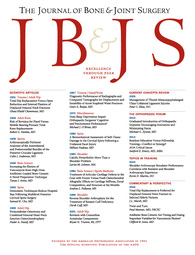
TRAUMA
Lower disability in short term for plate vs nail fixation of midshaft clavicular fracture
This report has been verified
by one or more authors of the
original publication.
J Bone Joint Surg Am. 2015 Apr 15;97(8):613-9.
120 patients with displaced midshaft clavicular fracture were randomized to receive either open reduction and internal plate fixation, or intramedullary nailing. The purpose of this study was to determine and compare short- and midterm functional results and complication rates between fixation methods. In the short term (<6 months), less disability cumulatively was observed for the plate fixation group compared to the nail group, as evaluated by area under the curve (AUC) for the Disabilities of the Arm, Shoulder, and Hand (DASH) questionnaire between 6 weeks and 6 months. Nevertheless, mean DASH scores at 6 months did not significantly differ between groups. There was no significant difference in complication rates.
Unlock the full ACE Report
You have access to {0} free articles per month.Click below to unlock and view this {1}
Unlock NowCritical appraisals of the latest, high-impact randomized controlled trials and systematic reviews in orthopaedics
Access to OrthoEvidence podcast content, including collaborations with the Journal of Bone and Joint Surgery, interviews with internationally recognized surgeons, and roundtable discussions on orthopaedic news and topics
Subscription to The Pulse, a twice-weekly evidence-based newsletter designed to help you make better clinical decisions
Exclusive access to original content articles, including in-house systematic reviews, and articles on health research methods and hot orthopaedic topics
Or upgrade today and gain access to all OrthoEvidence content for just $1.99 per week.
Already have an account? Log in


Subscribe to "The Pulse"
Evidence-Based Orthopaedics direct to your inbox.
{0} of {1} free articles
Become an OrthoEvidence Premium Member. Expand your perspective with high-quality evidence.
Upgrade Now













































































